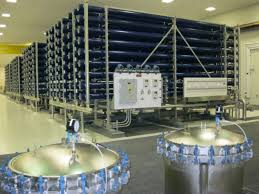Learn the working of RO plants
RO plants play a major role in converting any kind of water into potable water. Today water purification in every household is done using RO systems. Although boiling kills all the germs present in water, it cannot remove the particle impurities or the salt content of water. Hence, RO systems are used widely for removing salts and other dissolved impurities from water. RO stands for Reverse Osmosis. Reverse osmosis is a process that removes salt concentration from water (desalination).
Before learning how this is accomplished, let us see how osmosis works. A solution consists of solute particles mixed in a solvent. Let’s assume two different solutions but with the same solvent say water. Now if both the solutions have equal concentration of solute molecules, the solutions are said to be isotonic to each other, the solution with more solute molecules is called hypertonic and the solution with lesser solute molecules is called hypotonic.
Osmosis is a process that defines the movement of solvent between two solutions through a semi-permeable membrane. Semi-permeable indicates not everything can get through it. It normally blocks the bigger solute particles allowing only the solvent to pass through. Also this movement of the solvent always occurs from the hypotonic to hypertonic solution till the concentration becomes equal on both sides.
Now coming back to reverse osmosis, it occurs when osmosis happens against the gradient. That is, when the solvent is forced to move from the hypertonic to hypotonic. This process is widely used in commercial and residential water purification systems where we have saline and fresh water in close proximity. When pressure is applied on the side of saline water, saline water tends to move to the side of fresh water. During this activity the dissolved impurities like salt, fluorides or any other minerals are blocked by the membrane and they stay back. So only the filtered water passes through.
Most of commercially manufactured Reverse Osmosis (RO) membranes are usually made from cellulose acetate, polysulfonate, and polyamide. The membrane consists of a skin about 0.25 microns and a support layer about 100 microns. The skin is the active barrier and primarily allows only water to pass through.
The solution with salt and other minerals on the source side is flushed out of the system periodically. This helps the source side from becoming highly concentrated forming scales on the membrane. Also a pre filter is used for remove the substances which can damage the membrane and fine sediments that can clog the membrane.
Do ants sleep?
What is Aestivation?









